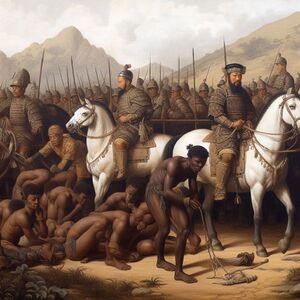Southern slave trade
 17th century depiction of Qian slavers with captured Polynesians. The face deformities shown are typical of Qian era artwork depicting humans. | |
| Date | 16th to 19th century |
|---|---|
| Duration | Roughly 300 years |
| Location | Audonia, Sarpedon, Crona, Australis |
| Type | Slavery |
| Motive | Profit |
| Organised by | Qian dynasty |
| Casualties | |
| est. 3 million dead from disease and mistreatment | |
| Displaced | 18 million slaves deported to Sarpedon |
The Southern slave trade also called the Cathay slave routes refers to the capture and enslavement of people mainly from the regions of Crona, Peratra and Audonia and their transportation across the vastness of the Ocean of Cathay to Sarpedon. The trade was regulated by the Qian dynasty and the main participants and executors of it were the South Seas Trading Company and other large Daxian slave cartels. The institution of slavery had existed in Daxia and its adjacent territories for centuries; the United Cities had been a state entirely based around the slave trade. But it was not until the territorial campaigns of overseas expansion of the Qian dynasty that slavery got official sanction. Concurrently with this territorial expansion were the first contacts with 'Western' explorers from Sarpedon and the establishment of the Southern route as a viable sea trade corridor to Sarpedon. The Imperium of Caphiria had a prodigious need for slaves that far outstripped the reserves of people susceptible to being enslaved in its imperial periphery. The growing economic relation between both powers based on the aforementioned sea route would feed the slave trade for centuries. The profits from the slave trade would grow to such an enormity that the Qian would start wars of aggression in northern Crona merely to round up more slaves. The operation was not without cost for Daxia, a number of great slave revolts erupted in various parts of the empire, draining the resources of the Qian in costly internal suppression and in lost economic activity. The Great slave revolt in xxx of xxxx lasted for four years before finally being put down by force, and even then thousands of slaves managed to free themselves.
Not even the outbreak of the Daxian Polynesian Wars would interrupt the flow of slaves to Sarpedon, powerful economic interests on both sides lobbied for immunity for ships carrying slaves from being boarded or hindered. The flow of slaves began to slow down in the late 18th century as sentiment in the Imperium began to sour on slaves of foreign origin; various new policies were enacted that made it easier and cheaper to possess Caphirian-born and educated slaves, even the middle classes had access to Volonian slaves and Slavic servants from the south. As the flow became a trickle, it eventually made less economic sense to export slaves over great distances; internal trading of slaves on the Audonian mainland continued to happen but the margins of profit were far smaller. Growing international distaste for the institution of slavery coupled with the financial collapse of the South Seas Trading Company had the Qian bureaucracy considering moving away from the practice but did this not happen; slave labor was still in use during the Second Great War and continued to exist until the end of the dynasty; the new republican government under Dai Hanjian finally banned the practice in 1949. The troubled legacy of the southern slave trade and Daxia's role in it continues to cast a dark pall in relations between Daxia and many countries in Crona and elsewhere. Daxian governments have repeatedly refused to issue any apologies or any type of compensation; in their view the matter is only a subject for historians to discuss.
History
Background
Slavery has been practiced in mainland Daxia for thousands of years. There are copious archeological records and fragments that point to the widespread keeping of slaves by the elites of the Xie dynasty. Pots of the Wangchu site have pictures of what appear to be human auctions.